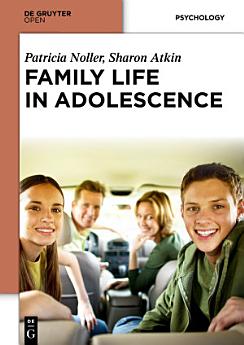Family Life in Adolescence
ઑક્ટો 2014 · Walter de Gruyter GmbH & Co KG
4.3star
3 રિવ્યૂreport
ઇ-પુસ્તક
222
પેજ
reportરેટિંગ અને રિવ્યૂ ચકાસેલા નથી વધુ જાણો
આ ઇ-પુસ્તક વિશે
Many parents fear the time when their beautiful happy children will become unmanageable adolescents continually engaging in risky or destructive behaviour. Unfortunately, this view of adolescents is the focus of the media, even though it relates to just a small proportion of young people.
As the large amount of research we report shows, most adolescents are responsible young people who care about their families and crave the support of their parents. It is also true, however, as much research indicates, that the quality of the relationship parents have with their adolescents is crucial to the wellbeing of those young people. We discuss the need for parents to set reasonable limits on their adolescents and to expect appropriate behavior. We also show, on the basis of research, that children who have experienced positive, caring relationships with their parents are more likely than other adolescents to behave responsibly. In other words, behavior in adolescence does not ‘come out of nowhere’ but builds on earlier experiences in the family.
Because of the large amount of research reported in this volume, we expect that it will be useful to practitioners from a range of professions that are likely to focus on adolescents: social workers, youth leaders, welfare workers, religious leaders, psychologists and psychiatrists and contribute to a better understanding of young people and their development, and the importance of families to that development.
As the large amount of research we report shows, most adolescents are responsible young people who care about their families and crave the support of their parents. It is also true, however, as much research indicates, that the quality of the relationship parents have with their adolescents is crucial to the wellbeing of those young people. We discuss the need for parents to set reasonable limits on their adolescents and to expect appropriate behavior. We also show, on the basis of research, that children who have experienced positive, caring relationships with their parents are more likely than other adolescents to behave responsibly. In other words, behavior in adolescence does not ‘come out of nowhere’ but builds on earlier experiences in the family.
Because of the large amount of research reported in this volume, we expect that it will be useful to practitioners from a range of professions that are likely to focus on adolescents: social workers, youth leaders, welfare workers, religious leaders, psychologists and psychiatrists and contribute to a better understanding of young people and their development, and the importance of families to that development.
રેટિંગ અને રિવ્યૂ
4.3
3 રિવ્યૂ
લેખક વિશે
Patricia Noller, Emeritus Professor, School of Psychology, University of Queenland, Australia
આ ઇ-પુસ્તકને રેટિંગ આપો
તમે શું વિચારો છો અમને જણાવો.
માહિતી વાંચવી
સ્માર્ટફોન અને ટૅબ્લેટ
Android અને iPad/iPhone માટે Google Play Books ઍપ ઇન્સ્ટૉલ કરો. તે તમારા એકાઉન્ટ સાથે ઑટોમૅટિક રીતે સિંક થાય છે અને તમને જ્યાં પણ હો ત્યાં તમને ઑનલાઇન અથવા ઑફલાઇન વાંચવાની મંજૂરી આપે છે.
લૅપટૉપ અને કમ્પ્યુટર
Google Play પર ખરીદેલ ઑડિઓબુકને તમે તમારા કમ્પ્યુટરના વેબ બ્રાઉઝરનો ઉપયોગ કરીને સાંભળી શકો છો.
eReaders અને અન્ય ડિવાઇસ
Kobo ઇ-રીડર જેવા ઇ-ઇંક ડિવાઇસ પર વાંચવા માટે, તમારે ફાઇલને ડાઉનલોડ કરીને તમારા ડિવાઇસ પર ટ્રાન્સફર કરવાની જરૂર પડશે. સપોર્ટેડ ઇ-રીડર પર ફાઇલો ટ્રાન્સ્ફર કરવા માટે સહાયતા કેન્દ્રની વિગતવાર સૂચનાઓ અનુસરો.





